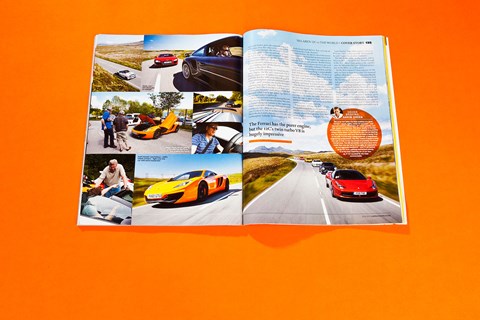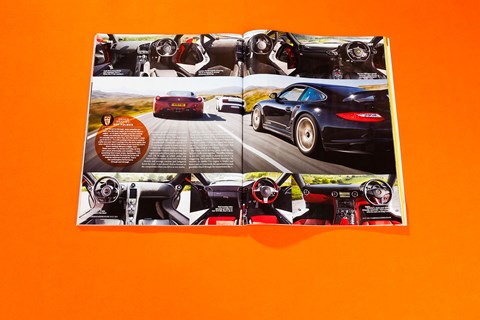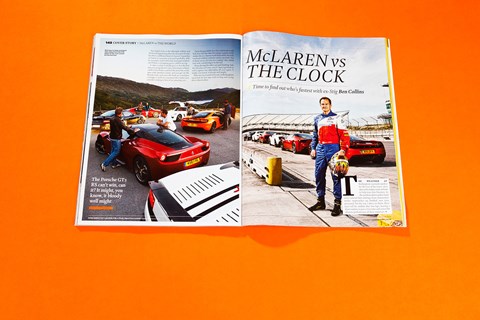► Shiny new 12C faces its toughest test
► 458, SLS, 911 GT2 RS, Gallardo, R8
► Under the microscope on road and track
It’s the group test to end all group tests: McLaren 12C versus Ferrari 458 versus every other supercar that matters. Can anything overwhelm the mighty McLaren? Three days on road and track should settle it once and for all.
So, this is IT, the big one. In a layby on an empty Welsh road linking nowhere in particular to somewhere else altogether sit a McLaren MP4-12C and Ferrari 458 Italia. Both cars are brimmed with superplus, fluids tickled to temperature, specs long since decided, minders long since departed. Finally they’re ours, and over the next couple of days we’ll drive them hard on road and track, after which their tanks will be empty and their tyres will be fried and we will say once and for all which is best.
The McLaren carries the momentum into this test; it’s the car that’s watched the 458 from a distance and had time to figure out how to do it better. Gut feel – and lots of hypey PR – says it’ll win.
Yet the McLaren experience begins with frustration as you fruitlessly try to find its automotive clitoris of a ‘door handle’ – you stroke the underside of the door’s strake and, so the plan goes, the aperture pops open. You’ll get it eventually, but a valet parking attendant will doubtless one day die of old age before retrieving a 12C from a hotel car park.
Once the door is open, it’s like one of those big pointy foam hands that annoying people wear in football stadiums. It points at your face and narrows your range of movement for straddling that thick carbon monotub and placing your feet into the faraway footwell.
Then you close the door and settle into a seat that’s more comfortable than the Ferrari’s (optional) bucket, press the starter button and it becomes clear that what we’re dealing with here is a game-changer: the McLaren is mind-blowingly quick, it rides exceptionally well and the way it stays so flat and composed through fast corners is downright spooky. You just look at where you want to go, decide on the amount of lock you need and power your way through – no confidence-lifts off the throttle, no extra nibbles at the wheel. Wow.
Being naturally aspirated, the Ferrari has the purer engine, but the 12C’s twin-turbo V8 is hugely impressive. It settles to a surprisingly gruff idle, but that melts away when all 443lb ft comes on strong from 3000rpm and doesn’t taper – at all! – until 7000rpm, one big fist of torque punching you down the road. Turbo engines typically don’t like to rev but it still feels right to wring the McLaren’s neck and give it the full 8500rpm when you’ve got space. Up there it doesn’t feel turbocharged at all.
The Ferrari certainly won’t be having this one all its own way. But to presume it’s either McLaren or Ferrari taking top honours is like expecting your F1 team-mate to dive out of the way or crash to help you win – there are other cars vying for your £170k or so, too. So in that same layby sit Mercedes SLS AMG, Porsche 911 GT2 RS, the Lamborghini Gallardo Performante and the Gallardo-based Audi R8 V10. You can snap up one of those for £109k. Peanuts!
It had to be here, the R8: it’s the evolutionary footstep where the hunched apeman transitions into the upright Homo sapien, the supercar you can take home to your parents. Would Ferrari and McLaren and everyone else have put such a focus on all-round ability without it? Doubt it.

Climb in and the switchgear and dials and the touch and smell of everything is unmistakably Audi. Perhaps you might not like a TT driver to feel quite so at home, but the R8 is so un-Audi-like and so un-Lamborghini-like to drive that it’s genuinely bewildering. It just feels so light and lithe and linear. Is it sure it’s not adopted?
The R8 flows over tricky roads like a rolling pin over hot dough, the steering is delicately weighted and the engine is just magnificent, the way it’s so docile around town and quiet when you want to fly under the radar, but when you open the taps it spins so freely and smoothly and the note hardens to such an intensely frenetic waaaaaaa that it’s just amazing.
When you’re driving the balls off this thing and you grab the gearlever it snaps into the centre of the gate and from there you just slice it through what feels like a very slight magnetic force and into the next cog. Bliss.
I got chatting to an AMG engineer about the R8 at the Geneva show in 2008. ‘Great isn’t it?’ he said. ‘Light like a feather. Fantastic.’
The R8 clearly made an impression, and its focus on all-round usability has filtered through to the SLS – Merc’s first return to the segment since the Mercedes/McLaren SLR joint project, just as the MP4-12C is McLaren’s.
Yet the SLS is more GT than supercar. It’s the only car here to have its 6.2-litre V8 mounted up front, albeit slung way back in its extraordinarily long snozz for excellent weight distribution. Prod the throttle at idle and the SLS rocks like a hot rod; gun it on the move and it lets rip like Keef Richards coughing up phlegm then unleashing a solo to blow Slash into his Marshall stack; get on the throttle early in corners and you’ll feel the rear end twitch and squirm. It is unique in this group for its raw musclecar attitude, yet it has civility too, what with its comfy seats, excellent infotainment system and beautifully put together, special-feeling interior. And it steers with an immediacy and delicacy that confounds your expectations when you first peer down that aircraft carrier bonnet.
Yet there are flaws. The dual-clutch ’box is infuriatingly reluctant to respond to paddleshift commands, and the GT focus means it turns to mush on track. I liked the ride quality when I drove it on smoother French roads last year, but it gets too spiky when you’re driving fast over UK B-roads, at which point you descend into a vicious circle with the sharp throttle and average traction and kangaroo down the road. It just doesn’t feel as focused as the competition when you drive at ten tenths.
Still, big miles are far more easily swallowed in the SLS than the Lamborghini Performante, the drop-top version of the hardcore Gallardo Superleggera. Drive it for a few hours and you’ll tire of the Lambo’s lumpy low-speed ride, dated sat-nav, windy hood and fixed-back seats that cosset like a kick in the kidneys.
But when you’re driving great roads for the hell of it, it all comes together. The differentiation to the R8 – with which it shares its DNA – is staggering. The Lambo’s fantastic steering is far meatier; its similar V10 engine is louder and fiercer; and, in Corsa mode, the automated manual gearshifts whack through the transmission like a sledgehammer pounding an anvil. Its four-wheel drive chassis is also more front-biased than the Audi R8’s, so it claws its way over crests, pulls you through corners like a roller coaster. It is packed with addictive drama, yet anyone can pedal this Lamborghini quickly.
And so we drive and drive, supercar headlights catching in supercar mirrors, engines wailing, speeds escalating, surprised sheep pulling the splits as we hove into view, the road running and running into the distance, and every single one of us coming back to that same layby and clambering out, eyebrows raised. ‘That was brilliant,’ we all gush about everything. But after half a day one thing is clear: the McLaren has not pulled a gap to the Ferrari.
As soon as you move off in the Ferrari it just feels so together, every corner of the car in sync with the other, the whole thing shifting like one tight unit, just like the McLaren. Yet despite this rock-solid resolve it rides incredibly compliantly – not as well as the McLaren, perhaps, but well enough. Then you floor the throttle and, as the chap who stumbled on our shoot and asked for a ride observed: ‘F**k, f**k, f**k, oh my god, f**********k!’

The steering is so swift that the way it pivots around its grippy front end takes your breath away, the brake pedal has a solid feel that you immediately trust and the gears fire home with just a tap of your pinky on the paddleshift, a subtle blur to the Lambo’s cataclysmic blow.
But what I love most about the 458 is the absolutely precise interaction between the accelerator, the rear tyres and the E-diff, the way you can mete out the power so accurately and feel the effect of every stroke of throttle on the way the rear tyres dig into the Tarmac. It’s a key part of the appeal of this non-turbo’d V8, but that it’s also sonically incredible – that it evolves from an unsteady bwaaaaaaaaaa to a near-F1 scream – and that it revs so energetically and with such a lack of inertia makes it the best engine of a spectacular group.
When you drive the Ferrari hard, there’s not really anything you can point at and say ‘That’s it, that’s the something I don’t like.’ You can with the McLaren: the mushy response of its endlessly strong £9.8k carbon brakes; the sleepy throttle response that makes the Ferrari feel wired on Red Bull; the shunt when you back in and out of the throttle and the turbos are fully lit; the non-linear effect when the spoiler turns into an airbrake on high-speed stops; the unnecessarily heavy effort it takes to pull the paddleshift, a by-product of the pointless pre-cog system (you give the paddle a soft pull so the gear can be ready, then a hard one so it instantly engages); the fact that Ferrari’s manettino is the more intuitive interface for shifting between stability modes and shift speeds and so on.
More tellingly, you might find yourself bounding cross country at custodial speeds in the McLaren and craving just a bit more drama.
But when I drove a 458 to Goodwood from Maranello last summer, it was clear McLaren could attack it in the all-rounder stakes – cruise control, comfier seats, less noise, and none of those daft steering wheel-mounted indicators and wipers that I still can’t fathom. And Woking has achieved much of that – the McLaren is the easier car to live with.
Two of the best drives I had in the McLaren came when we were heading back from our shoot in the dark, and I wound down the pace a little and just wanted to get back to the hotel. Suddenly I started to prefer the 12C’s calmer steering to the Ferrari’s manic rack, preferred the more linear precision of its response immediately off-centre. I began to appreciate how succinctly you could link together a series of bends and how absolutely bloody brilliant that ride quality is. These were proper, seared-in-the-back-of-my-mind magic moments, moments when I started to ‘get’ what the McLaren was all about.
But here’s a twist: the Porsche GT2 RS. The rear-wheel drive, twin turbo 911 has a widow-maker reputation, and you’d think that adding an RS suffix to that nomenclature would only fast-track you to the nearest morgue. And, yes, the power and torque outputs have swollen, but the ride’s now more compliant, so this Porsche does a better job of keeping itself attached to Tarmac, so it’s actually easier to drive hard. And because it’s an evolution of a decades old design, it feels instantly, reassuringly familiar. There are actual door handles and indicator stalks, windows you can see out of, a clutch pedal and gearstick, and a button that you push once to instantly disable absolutely every safety net, rather than giving it the weird Masonic handshake that the McLaren demands.
Porsche is lucky that it didn’t once rain during our shoot, because we all know that the super-sticky Michelin Cup tyres are to be trusted around standing water like George Best was around alcohol. But here, under a white-hot June sun and wide-open blue sky, the GT2 RS is life-affirmingly good, spitting its anodyne, boost-laden soundtrack over the moors like the RAF jets that scorch overhead.
You might look at the 6800rpm redline and think it disappointing after the 9000rpm Ferrari, but this is a different kind of visceral. It punches on boost at 2500rpm and you’ll probably shift by 5500rpm, and within that 3000rpm window you’ll have a whopping great 516lb ft on tap.
It takes a while to build up to it, but the first time you swing the GT2 into a fast corner without a dab on the brakes and feel the nose bite at the apex with absolute clarity and you get on the throttle early and sense the back arc round just a smidge is, well, it’s a moment that makes you consider ranking it first of six amazing cars.
I love the gearshift, love the solid brake pedal feel, love the fact that the torque surplus really makes the 911 chassis work hard while the well-resolved stability controls watch your back. Not so keen on no air-con on a 24degC day, mind, and, erm, sod driving it in the wet.
I keep driving the other cars and thinking ‘nah, the Porsche can’t win, can it?’ then I get back in and it ignites my adrenaline all over again. It might, you know, it bloody well might.
Only one way to settle it for sure: to Rockingham racetrack for fast laps with ex-Stig and racing driver Ben Collins.
